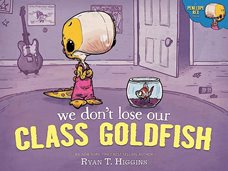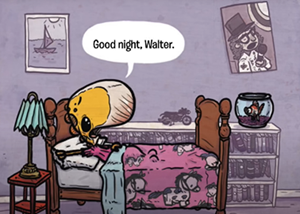This month’s Book Nook topic is...
Building Story Comprehension with We Don’t Lose Our Class Goldfish


By Ryan T. Higgins
|
Sharing books with children is a great opportunity to build reading comprehension, which involves helping children make sense of the story. In this Book Nook, we’ll share research-based strategies for helping children understand the basic structure of a story. This includes understanding:
- who the characters are
- where the story takes place
- what the main problem is
- what actions are taken by the character(s) to solve the problem; and
- the resolution to the problem
Keep in mind that it’s best to read and talk about a story multiple times to help build understanding. Read on to learn how to build understanding throughout multiple readings!
|
Why we chose this book
With back-to-school just around the corner for many, it’s a perfect time to share this fun story featuring Penelope the T-Rex and the classroom pet, Walter. This story is great for building reading comprehension as there is a clear problem Penelope must solve. Penelope is fearful of Walter, so she is very unhappy to learn each of the students will take turns bringing him home on the weekends to care for him. When it’s her turn to bring him home, something terrible happens: Walter goes missing! In her search, Penelope realizes that perhaps Walter isn’t as frightening as she originally thought.
The First Reading
The first time you read We Don’t Lose Our Class Goldfish, the goal is to get a sense of the story from both the text and the pictures. CSPAR (pronounced caspar) is an acronym used to represent key elements that are present in most stories – the Characters, the Setting, the Problem, Actions taken to solve the problem and the Resolution. During the first reading, you can pause to point out different elements of CSPAR, such as:
- Characters: You can begin with the front cover. After reading the title, you could point to the dinosaur and say, “This is Penelope. The story is about her and her class goldfish, Walter.”
- Setting: You can talk about where the story takes place. While still looking at the front cover, you could add: “This story takes place at Penelope’s house. She has to bring her class goldfish home for the weekend.”
- Problem: As you read, you will uncover the problem in this story. You could say: “Uh-oh, Penelope lost Walter – that’s a big problem!”
- Action: You can highlight the actions that Penelope takes to try to find Walter. For example: “Penelope is looking everywhere for Walter! She is even checking in the bird’s nest and under a log.”
- Resolution: At the end of the book, you can talk about the resolution. You could say, “Penelope solved the problem when she finally found Walter in her dad’s car!”
Next Readings
Now that the child is familiar with the story, we can highlight and label the CSPAR terms. It’s okay if these terms are new to the child. Here are some examples of how to label and explain the CSPAR elements:
 If the child points to or makes a reference to Penelope, you could say, “Penelope is the main character in this story. She is the one who the story is about.”
If the child points to or makes a reference to Penelope, you could say, “Penelope is the main character in this story. She is the one who the story is about.” - If the child shows interest in the pictures by commenting on Penelope’s bed, for example, you could say, “Yes, this is part of the setting, which is where the story takes place. In this story, the setting is at Penelope’s house. This is her bedroom – she put Walter on the bookshelf next to her bed.”
- If the child comments about how Walter goes missing, you could highlight, “That is a big problem! Penelope is worried about what her classmates will think about her losing Walter.”
- On the next few pages, Penelope looks for Walter in a few different places. If the child talks about the different places Penelope searches with no luck, you could say, “Yes, she is taking action by searching for Walter high and low!”
- After reading the story, you could say: “Penelope finally found Walter in the car. This was the resolution.”
Comments like these will ensure the child has a good understanding of the main events of the story. Now, they are ready to dive into a deeper understanding in the next reading.
Later Readings
Once you have shared the book with the child a number of times, you can encourage a deeper understanding of the story. To do this, begin to ask one or two questions to get the child thinking and talking about the story structure. You might ask:
- “Who is the main character in this story?”
- “What is the setting in this story?”
- “What is the problem the main character must solve?”
You can also use comments to help develop a more thorough understanding of the story. For example, you could say:
- “I am thinking the main character, Penelope, is feeling very worried that she won’t find Walter.”
- “I’m wondering how she will solve her problem.”
- “Let’s read all about Penelope’s actions to try and find Walter
Using the CSPAR framework is a wonderful way to help children develop story comprehension. Remember to only ask a few questions during each reading and balance your questions with comments so the reading is fun, and the child does not feel as though they are being tested. Pause after asking a question to give the child time to process and respond.
Helping the child consider the CSPAR elements in this story will also help them think about these elements in other stories you share.
Happy reading!
More resources
The strategies in this Book Nook post are drawn from Hanen’s practical, research-based guidebooks for building emergent literacy. Explore the links below to learn more about how these guidebooks can support you.
We’ll let you know when a new Book Nook topic
has been posted!
Return to Book Nook